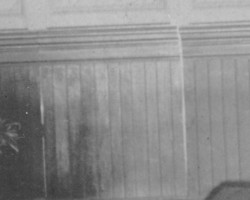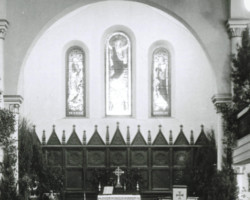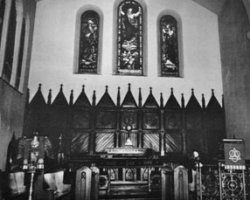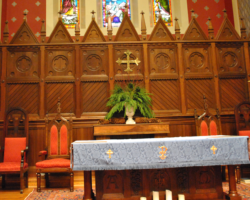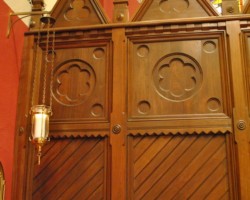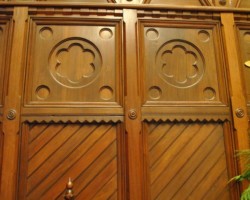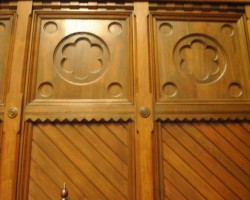A reredos is a large screen, altarpiece, or decoration that fits behind an altar. It can be made of various types of materials. It can be carved of marble or wood (as with St. George’s). It can be gilded or painted. (In 1906 it was painted). It can be low or many stories high. A reredos can frequently include niches for religious images. Ours panels but they have not been used for religious images. The top of the reredos had gothic points some time between 1906 and 1924. Were they added or part of the 1906 church and had been taken down ?
The reredos dates from approximately 1870’s when the church shifted from a more Calvinist design with the high altar to a more Catholic influenced tradition. There is no mention of it in the Vestry minutes.
The reredos is apparent in the 1906 and 1924 pictures of the church. There was actually a door in the reredos to the Vestry room behind which was eliminated in the 1925 renovation.
The reredos was removed in 1954 and stored in the gallery. The reason according to Barbara Willis was to see if it improved the the east wall appearance. The church was involved in changing other parts of the interior including the pew cushions.
Discussions about it return began in 1995 and accelerated with proposed changes on the east wall which was given to the Worship and Music Commission . The church had a wooden cross on loan from Christ Episcopal in Spotsylvania and it could not stay in the church forever.
The issue of the reredos was taken up in a 1998 congregational meeting which broadened the discussion. The thought was restoring the reredos and creating a new arch with a drop shadow in which a brass cross could be hung. The arc would also be in a line of light which combined would give the cross a larger appearance. The existing brass cross was seen as too small by some such as the Rev. Bob Dean. He suggested taking it from its base and suspending it over the Holy Table.
Charles suggested that all of this would not improve the use of chancel space but the refinishing of the reredos could make the “chancel lively.” He suggested an idea of moving the choir to the gallery and opening the chancel up. The chancel should contain the three main elements of our worship initiation , proclamation and celebration. He pointed to the limited communion rail space with possible additions to the east wall area would impede future growth. Organist Susan Onderdonk was for the this change but pointed to the lack of air conditioning .
The consensus of the meeting was to broaden the discussion to include the entire worship space in the chancel. This discussion led directly to the Nave Renovation Committee under Rev. Bill Preganall to redraw the chancel and to make the decision to move the choir and organ to the gallery. Nave Renovation also installed 4 new air handlers in the gallery to handle the issue of heat if the choir returned to the gallery.
In 1999 Worship and Music recommended restoring it without the gothic caps with a new memorial brass cross and appropriate lighting. The estimate to complete was $7,000. The original holy table was to be placed in Faulkner Hall. Mike Moyers was hired to do the work and to be done by Christmas of 1999. We paid Moyers $2,100 for the job in 2000.
Charles did not announce it was complete until early in 2000. It was mounted flush along the east wall. It wasn’t until the Nave renovation a decade later that it was moved out to its present position which is closer to where it was in 1906.
However a cross would not fit since the reredos was larger than anticipated. An ornate processional cross became the substiture.
Charles went on sabbatical in 2000 and there was discussion about restoring the gothic points. Donations were made within the Worship and Music commission for the work.
Click any picture to enlarge



